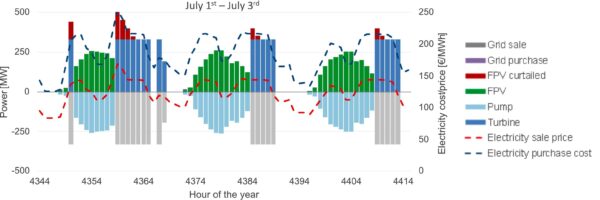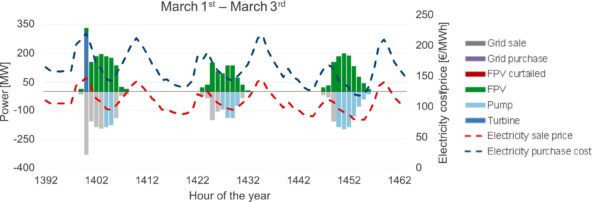Scientists from Italy’s Polytechnic University of Milan (Politecnico di Milano) have conducted a techno-economic optimization for the addition of floating PV (FPV) to three existing pumped hydro storage (PHS) plants in the country.
“In this work, we have included several effects that have been overlooked in the literature, particularly the reduced evaporation rate from the water basin, the influence of the variation in temperature of the solar cells due to the presence of water, and the impact of the part-load operation of the pumps and turbines in hydroelectric plants,” corresponding author Dr. Matteo Catania told pv magazine. “By evaluating these effects, we propose a novel operating strategy for pumped hydroelectric plants, which could lead to dramatic performance improvements.”
The optimization was formulated as a mixed-integer linear programming (MILP) model, finding the best solution while using both continuous and integer variables under linear constraints.
“By applying this model to different plants, we aim to derive broader conclusions regarding the economic feasibility of integrating FPV with PHS,” the team said. “The findings obtained from our analysis hold significance beyond the specific plants studied, as they can be extrapolated to numerous hydroelectric facilities located in geographical regions sharing similar characteristics to Italy.
The three PHS plants analyzed were Bargi of Northern Italy, Capriati of the Center-South, and Taloro, located on the island of Sardinia. Based on the ratio between the maximum installable FPV and the power capacity of the smallest pump, the researchers have set an integration potential parameter (IPP) metric for each plant, reflecting its presumed practicality and efficiency. In this case, Taloro demonstrated the highest IPP, Capriati the lowest, and Bargi is placed in between.

More specifically, Taloro has a pumping capacity of 280 MW, an upstream basin volume of 60.50 Mm³, a downstream basin volume of 18.80 Mm³, a downstream basin surface of 0.82 km², and an average yearly irradiance of 182.83 W/m². Capriati has a pumping capacity of 113 MW, an upstream basin volume of 8.55 Mm³, a downstream basin volume of 4.80 Mm³, a downstream basin surface of 0.11 km², and an average yearly irradiance of 178.60 W/m². Bargi has a pumping capacity of 330 MW, an upstream basin volume of 6.28 Mm³, a downstream basin volume of 43.85 Mm³, a downstream basin surface of 1.50 km², and an average yearly irradiance of 156.29 W/m².
With those parameters, among others, as inputs, the MILP algorithm runs on the Pyomo software. As an output, the model has then provided the preliminary plant operation results as well as the optimal FPV capacity. In all cases, the FPV was only installed on the lower basin using 440 W panels with an efficiency of 20.39%.
“For each plant, four cases were considered for investigation,” the academics added. “The configurations were PHS alone (case 1), PHS with FPV connected only to the pumps (case 2), PHS with FPV connected to the grid and pumps (case 3), and PHS and PV ground separated (case 4). Case 1 represents the operation of the PHS with no installation of FPV and is used as benchmark; Case 4 aims to compare the operation of PHS and a PV field installed on the ground.”

In the Bargi plant, the optimization demanded a PV capacity of 305.84 MW in cases 2-4; Taloro demanded 167.19 MW in cases 2-4; while the Capriati plant demanded a capacity of 22.43 MW in cases 3 and 4, and no PV for case 2. “Installing FPV panels prevents 8% to 18% of water in the lower basin from evaporating, saving millions of cubic meters per year and potentially increasing PHS productivity,” the team added.
As for performance results, the team focused on cases 2 and 3. Case 2 had a net present value (NPV) of €50 million ($52 million), €15 million, and €153 million for Bargi, Capriati, and Taloro, respectively. The minimum basin coverage was 60%, over 100%, and 10%, respectively. Case 3 had an NPV of €168 million, €29 million, and €194 million for Bargi, Capriati, and Taloro, respectively. The minimum basin coverage was 20% for all PHS plants in case 3.
The NPV of the three plants investigated exhibited an increase, with a maximum of a six-fold increase compared to the baseline PHS operation.
“Results of the analyses show that the integration of FPV in a PHS system improves its economic performance. The possibility of FPV installation is always exploited for all the Taloro and Bargi plants, while for Capriati is exploited only if it is possible to sell electricity back to the grid,” the researchers noted. “In conclusion, this work shows the high potential of FPV-PHS integration presenting a promising system which can help in meeting the ambitious targets set for the energy transition.”
Leave a Reply